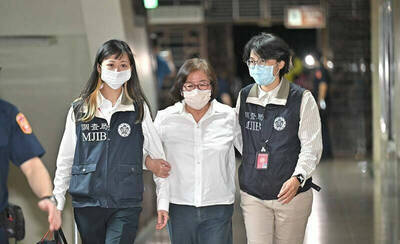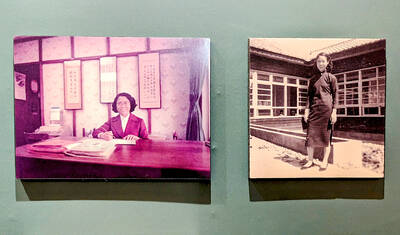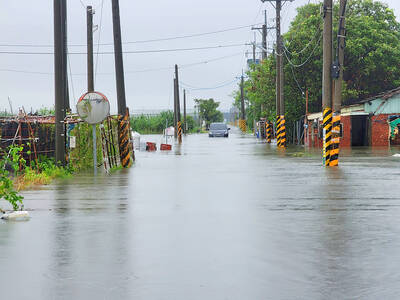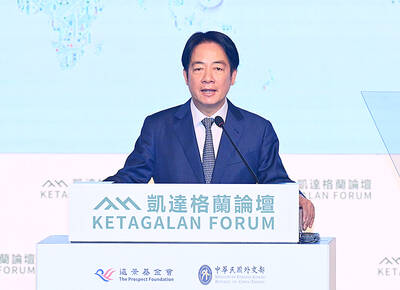Along with baking heat, air-conditioner drip and typhoon alerts, late July signals the coming of the summer music festival season. In the next few weeks, several of the world’s biggest names in rock and pop will sweep through East Asia, and though we will get to see many of them in Taipei — Massive Attack, Broken Social Scene, Atari Teenage Riot and Steve Aoki to name a few — the epicenter of this annual rock ’n’ roll earthquake continues to be in Japan.
Both the Fuji Rock Festival, from July 30 to Aug. 1 in Naeba, Japan, and Summer Sonic, in Tokyo and Osaka on Aug. 7 and Aug. 8, boast monster lineups that are feeding the region.
Taiwanese bands will play a small part in the action. Go Chic, a Taipei foursome mixing dance rock with riot grrrl energy, will become the third Taiwanese band to play Fuji Rock when it performs there next Saturday night. At the same time, they will also become the first non-Japanese band to play the Rookie-a-Go-Go stage there, a free stage outside the festival gates where bands compete for a proper berth in the next year’s festival.
Taiwan’s senior rocker Wu Bai (伍佰) is also traveling to South Korea’s Pentaport Festival, where he performs today, and next weekend Taiwan’s best reggae band, Matzka, will play the Jisan Valley Rockfestival, also in South Korea.
Fuji Rock, in its 14th year and located in a ski resort 150km north of Tokyo, however, ranks as the senior Asian rock fest. The headliners it announces as early as February each year now regularly add dates at other concerts in Taiwan and South Korea, such as the upcoming TWinkle Festival at the Taipei World Trade Center Nangang Exhibition Hall (台北世界貿易中心南港展覽館), which has managed to recruit Massive Attack, Kula Shaker and Ian Brown from Fuji Rock’s lineup. [See Highlight below.]
Other headliners at this year’s Fuji Rock include the Brit band Muse as well as one of the first concerts in 20 years by new wave pioneers Roxy Music. They are joined at the top of the bill by John Fogerty, who played Woodstock with Creedence Clearwater Revival over 40 years ago, and a new band called Crooked Vultures that includes Nirvana drummer Dave Grohl and Led Zepplin bass player John Paul Jones. And that’s just the festival’s main stage.
On Fuji Rock’s 14 other stages, leading indies like electro-pop duo Air and dance rockers MGMT will cap an utterly eclectic offering of more than 250 acts that spans from big-band mambo groups, hula dancers and all varieties of rock to all-night raves and even circus sideshow acts.
When it comes to choosing artists, says Johnnie Fingers, one of Fuji Rock’s promoters, “the live performance is king.”
“I personally go to other festivals, like SXSW, the Great Escape and ADA to check for new artists. We’re always looking. A good record creates interest, but if the artist’s show is no good. Then we have to pass,” he says.
But as a camping festival where many of the 40,000 attendees at Fuji Rock each day have been coming for several years, the event has become about more than just music.
“As time goes on, the festival has developed into not being just about rock performances,” says Fingers. “Fuji Rock is a social and lifestyle event, a weekend away from the Monday-to-Friday grind in a beautiful setting. The audience has grown to think of it as their festival, and we have that in mind all the time.”
Summer Sonic, Japan’s urban summer rock festival, poses a sharp contrast. Held just one week after Fuji Rock in a baseball stadium and convention center on the fringes of metro Tokyo, its lineup plays out like the wet dream of some music company executive.
Taylor Swift and Jay-Z will fill the niche for current Top-40 talent, while an all-star lineup of 90s alternative and hip-hop acts will be filled out by the Smashing Pumpkins, the Pixies, Pavement and A Tribe Called Quest. But the top festival slot goes to none other than the 60-year-old R ’n’ B legend Stevie Wonder, who’s already been generating headlines for performances at major European festivals in the early part of the summer.
For Taiwan’s music fans, the magnetic draw of such big names and mega-festivals is increasingly enough to overcome the steep ticket prices. (Festival passes alone can cost NT$10,000 to NT$15,000).
A Facebook group called “I Want to Go to Fuji Rock” (我要去 Fuji Rock) has so far garnered more than 350 fans, of whom around 30 will make the pilgrimage to Fuji Rock this year. In the festival campground, they plan to fly a flag with the Taiwan Tourism Bureau’s “Taiwan” logo and the words “I am Taiwanese” (哇系台灣郎).

Following the shock complete failure of all the recall votes against Chinese Nationalist Party (KMT) lawmakers on July 26, pan-blue supporters and the Chinese Communist Party (CCP) were giddy with victory. A notable exception was KMT Chairman Eric Chu (朱立倫), who knew better. At a press conference on July 29, he bowed deeply in gratitude to the voters and said the recalls were “not about which party won or lost, but were a great victory for the Taiwanese voters.” The entire recall process was a disaster for both the KMT and the Democratic Progressive Party (DPP). The only bright spot for

Aug. 11 to Aug. 17 Those who never heard of architect Hsiu Tse-lan (修澤蘭) must have seen her work — on the reverse of the NT$100 bill is the Yangmingshan Zhongshan Hall (陽明山中山樓). Then-president Chiang Kai-shek (蔣介石) reportedly hand-picked her for the job and gave her just 13 months to complete it in time for the centennial of Republic of China founder Sun Yat-sen’s birth on Nov. 12, 1966. Another landmark project is Garden City (花園新城) in New Taipei City’s Sindian District (新店) — Taiwan’s first mountainside planned community, which Hsiu initiated in 1968. She was involved in every stage, from selecting

Water management is one of the most powerful forces shaping modern Taiwan’s landscapes and politics. Many of Taiwan’s township and county boundaries are defined by watersheds. The current course of the mighty Jhuoshuei River (濁水溪) was largely established by Japanese embankment building during the 1918-1923 period. Taoyuan is dotted with ponds constructed by settlers from China during the Qing period. Countless local civic actions have been driven by opposition to water projects. Last week something like 2,600mm of rain fell on southern Taiwan in seven days, peaking at over 2,800mm in Duona (多納) in Kaohsiung’s Maolin District (茂林), according to

As last month dawned, the Democratic Progressive Party (DPP) was in a good position. The recall campaigns had strong momentum, polling showed many Chinese Nationalist Party (KMT) lawmakers at risk of recall and even the KMT was bracing for losing seats while facing a tsunami of voter fraud investigations. Polling pointed to some of the recalls being a lock for victory. Though in most districts the majority was against recalling their lawmaker, among voters “definitely” planning to vote, there were double-digit margins in favor of recall in at least five districts, with three districts near or above 20 percent in